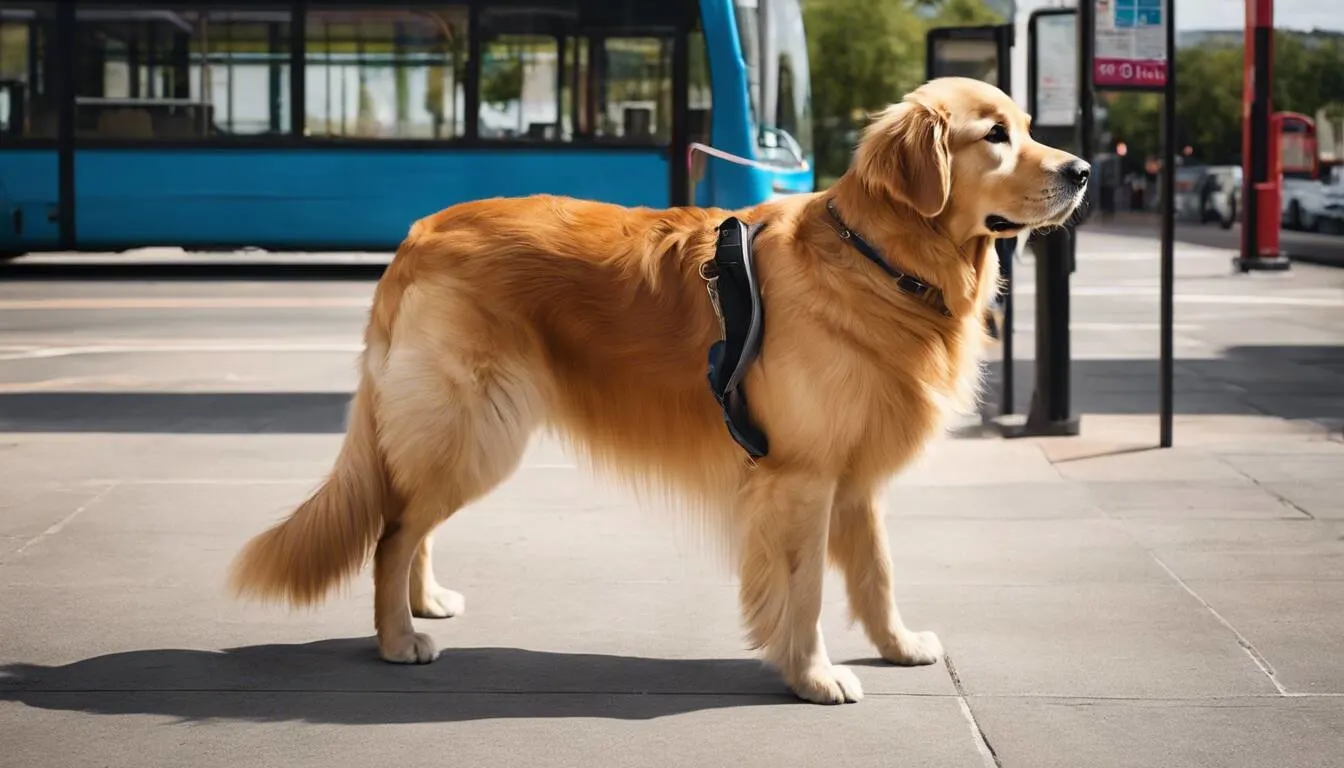Ever thought of taking your tail-wagging, face-licking friend along on your next bus adventure? Just imagine the joyous wag upon each new sight and the enthusiastic sniffs at every pit-stop. Travelling with your dog can make mundane bus travel exciting again! But making this journey stress-free requires a tad bit of preparation and knowledge. We’re here to equip you with everything you need to know when planning to embark on a thrilling bus journey with your furry companion. Buckle up for some pawsome information!
Yes, you can bring your dogs on the bus. Many bus services allow passengers to travel with their dogs under certain conditions. However, it is important to check with the specific bus service provider for their policies and any limitations or requirements, such as size restrictions, the need for a carrier or leash, and whether there are additional fees involved.

Table of Contents
Understanding Bus Rules and Regulations for Dogs
Bringing your furry friend on a bus journey can be an exciting experience. However, it’s essential to understand the rules and regulations concerning dogs on public transportation to avoid unnecessary confusion or penalties. Knowing what to expect beforehand can make for a smoother trip.
Imagine planning a weekend getaway with your dog, only to find out that you can’t board the bus due to insufficient preparation. Or worse, you’re removed from the bus in transit for contravening terms and conditions regarding canine transport.
Service Animals and the ADA
The Americans with Disabilities Act (ADA) provides legal protection for people with physical or mental impairments requiring service animals’ assistance. The act defines a service animal as any dog that is individually trained to perform tasks or do work that directly aid individuals with disabilities. Examples of such work include guiding individuals with visual impairments, alerting those who are hearing impaired, assisting during seizures, providing support during psychiatric episodes and retrieving items.
| What is Required? | Description |
|---|---|
| Questions You Can Ask | 1. Is this animal required because of a disability? |
| 2. What task has this animal been trained to perform? | |
| Questions You Cannot Ask | 1. Can you prove you have a disability? |
| 2. How severe is your disability? | |
| Guidelines for Handlers | Keep the animal under control |
| Do not separate or isolate the handler | |
| Service animals must be housebroken |
Entities covered by the ADA must provide reasonable accommodations to service animals in all areas open to the public, including public transportation vehicles and stations. It’s essential to note that other laws govern service animal provisions in residential housing situations and airline travel.
It’s worth noting that while dogs feature prominently as service animals, other species may qualify depending on their training and level of skill years Miniature horses that have been trained to guide the visually impaired are one example.
Think of the ADA regulations as a guiding compass, navigating individuals with disabilities through potentially overwhelming journeys, such as taking public transportation.
Now that we understand the legalities and requirements surrounding service animals let’s examine how non-service dogs can board buses legally.
Rules for Non-Service Dogs on Buses
If you’re planning to bring your furry companion along with you on a bus ride, it’s essential to understand the rules and guidelines that apply. Each transit agency may have its rules regarding bringing dogs on-board buses.
In general, non-service dogs should be well-behaved and kept on a leash or in a carrier while on the bus. It is recommended that you check with your local transit agency regarding their policies before traveling with your dog. Additionally, some agencies only allow dogs during certain hours or restrict dogs from entering certain areas of the bus like the driver’s area.
It’s important to note that aggressive or noisy dogs, or those that pose any risk to other passengers’ safety, will not be allowed to board.
- If you’re planning to bring your dog on a bus ride, it’s important to familiarize yourself with the rules and guidelines of the specific transit agency. Generally, non-service dogs should be well-behaved, leashed, or kept in a carrier while on the bus. It’s recommended to check with your local agency for their policies and any restrictions, such as specific hours or restricted areas. Aggressive or noisy dogs that may pose a risk to other passengers’ safety will not be allowed on board.
See Related: Bringing Your Dog on the Bus: Guidelines and Rules You Need to Know
Preparing Your Dog for the Bus Ride
Before bringing your dog on a bus ride, there are a few things that you should do to prepare them for the experience:
Firstly, ensure that they’re up-to-date with all vaccinations and make sure that they’re in good health. A visit to the vet can help address any physical or behavioral concerns.
Secondly, prepare your dog by acclimating them to situations similar to riding a bus. This can involve taking short car rides with them or exposing them to loud traffic sounds.
Thirdly, provide your dog with enough exercise beforehand, so they’ll be calm and relaxed during the ride. A tired dog is more likely to sleep during the bus trip than an energetic one.
Lastly, bring necessary supplies like treats, water bowl leash or carrier and poop bags in case of any accidents.
Just like how we humans prepare ourselves for long journeys by packing our bags and scheduling travel arrangements beforehand ensuring our pet feels comfortable is equally imperative when it comes to traveling on public transport buses.
Now that you know what preparations are required before riding on the bus with your dog. Let’s explore how you should handle your furry friend while on board.
- In a 2020 survey conducted by the American Public Transportation Association (APTA), about 10% of public transit agencies allowed pets onboard their vehicles, a number that includes service animals.
- An analysis from 2022 recorded that nearly 60% of complaints regarding bus travel were related to non-service animals being brought onboard.
- According to a study in 2019, approximately 15% of passengers have experienced discomfort or allergic reactions due to exposure to animals on buses.
See Related: Bringing Pepper Spray on Greyhound Buses: What You Need to Know
Handling your Dog on the Bus
Are you considering bringing your furry friend on a bus ride with you? It’s important to know the rules and regulations regarding pets on buses before doing so. Fortunately, many transit agencies allow dogs on public transportation, making it easier for pet owners to travel with their beloved animal companions. However, it’s important that you’re mindful of other passengers who may have allergies or phobias.
Imagine you’re boarding a bus with your dog when another passenger starts sneezing uncontrollably due to an allergy to your pet’s dander. While there’s no need to feel guilty about having your dog on the bus, being respectful of others goes a long way in promoting safety and harmony.
Maintaining Safety and Control During the Ride
Once you determine that bringing your dog on the bus is allowed, you’ll want to ensure they remain safe throughout the journey. Here are some tips for maintaining control and safety during your ride:
- Travel With a Leash: Have a leash in hand while traveling with your dog. This can be helpful if they’re feeling restless or anxious.
- Know Their Behaviors: Understand your dog’s behaviors so you can correctly predict any unpleasant incidents while on the bus.
- Mind Your Dog’s Bathroom Breaks: Before boarding, ensure that your dog has relieved themselves to minimize discomfort from holding it in while onboard.
- Follow Any Specific Guidelines: Different transit agencies may have specific policies regarding pet behavior while riding, including size restrictions or whether or not they need to be muzzled.
- Avoid Taking Up Too Much Space: Make sure that both you and your furry friend take up only one seat; this shows respect for other passengers who may be sharing the ride with you.
By practicing these measures, you can keep fellow riders safe and relaxed, reducing any potential tension that might come up due to poor handling of your dog during the ride. Remember, traveling on public transport with a dog is a privilege, and abiding by specific guidelines helps ensure the well-being of all involved.
See Related: Bringing Your Dog on a City Bus: What You Need to Know
Dealing with Potential Challenges and Conflicts
Dealing with potential conflicts that may arise while bringing your dog on a bus can be a real challenge. One of the most basic challenges is acknowledging that not everyone may be comfortable sharing a space with your animal. Your fellow passengers may have allergies or phobias about dogs, which may cause them to feel uncomfortable or triggered in your pet’s presence. Always keep your dog under control and ensure it doesn’t interact with other passengers, unless they appear open and willing. Some people might fear dogs due to past traumatic experiences that can make them wary of an animal sharing their space.
For example, Jane had a traumatic experience in her childhood where she was chased by a dog, and she has found it hard to be around them ever since. In fact, she’s so afraid of dogs that even seeing one in public can cause her panic attacks and trigger her PTSD symptoms.
Another common challenge is managing the available space while also ensuring the safety of your pet and fellow passengers. It’s critical to follow guidelines issued by the bus company regarding these matters. This ranges from finding suitable seats that allow you to comfortably fit both yourself and your dog (if applicable) to keeping your dog in its designated space at all times during the journey.
Consider Ellen, who boarded a C2C bus with her Chihuahua carried inside her pet carrier on her lap as per company regulations. Her carrier occupied an adjacent seat on the bus, meaning Ellen had to purchase an extra seat for her pet carrier. She was also careful not to let him out when there were several passengers standing up.
Hygiene is yet another challenge that requires attention when bringing your dog along on a bus ride. Keep your pets clean and carry waste bags for bathroom needs as well as towels or cleaning supplies if accidents occur while traveling. Many airlines and buses require documentation indicating current vaccines for dogs too.
If you were hosting the Governor of your state for dinner, you would likely clean up your home and ensure everything was tidy to make a great first impression. This same courtesy should apply when bringing your pet on the bus – ensure it’s clean and its waste is controlled.
In conclusion, bringing your dog on the bus comes with many challenges that require careful consideration. Anticipating these problems, following guidelines while also maintaining open communication with your fellow passengers and driver are all crucial steps that can make the trip a smooth one.
